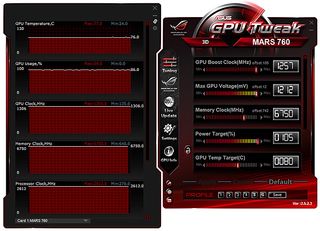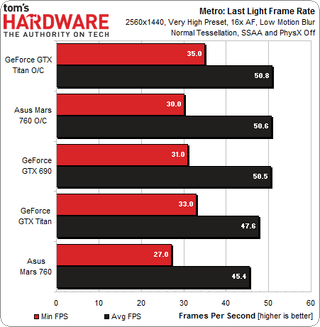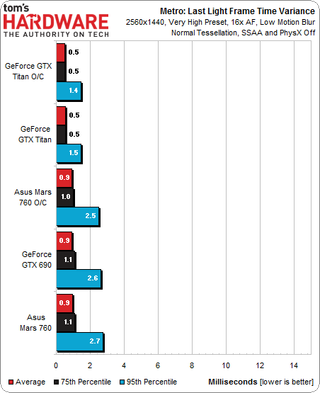Asus Mars 760 Review: Two GPUs In SLI; One $650 Graphics Card
We like the idea of two GK104 GPUs in SLI on one graphics card. Sounds like a GeForce GTX 690, right? Except that board costs $1000 and Asus' Mars 760 sells for $650. In a world with sub-$700 GeForce GTX 780 Tis, can this dual-GPU stunner still impress?
Overclocking
It's typically more difficult to get two GPUs in CrossFire or SLI overclocked aggressively than it would be to run one processor at elevated frequencies. If anything, you're always going to be limited to the peak clock rates of whichever card is slower.
I was surprised, then, to get our Mars 760 card running with a 185 MHz GPU Boost clock rate offset and a 742 MT/s memory data rate boost. Even more impressive, the reported 1257 MHz Boost clock setting was exceeded in both of the apps I experimented with (FurMark and Metro: Last Light), where I saw 1306 MHz under heavy load. Achieving those numbers required the Asus GPU Tweak utility, a 12 mV offset on the GPU, a 105% power target, and a fan speed manually dialed in to 80%.
Now, there is absolutely such a thing as vendors cherry-picking their best GPUs and memory for review samples. It happens all of the time, and we totally get the desire to put a best foot forward. I'm not saying that's what's happening here. But I would also caution our readers to consider our results knowing that we're benchmarking a review sample, and not a retail card. Your mileage may vary.

The result of our overclock is significantly more memory bandwidth than a stock GeForce GTX 690, with comparable shader processing power.


At least in this one application, the overclocked Asus Mars 760 achieves a frame rate that is almost identical to the vastly more expensive GeForce GTX 690. And again, while we obviously can't guarantee that retail boards will overclock as well as our sample, Asus has to be doing some sort of binning to get amenable GK104 processors able to stay under a certain thermal limit anyway. From what we've seen and heard in the real world, the Mars 760 is garnering a good reputation for overclocking well as a result.
Stay On the Cutting Edge: Get the Tom's Hardware Newsletter
Get Tom's Hardware's best news and in-depth reviews, straight to your inbox.
Current page: Overclocking
Prev Page Results: Grid 2, 5760x1080 Next Page Power, Temperature, And Noise Benchmarks-
vinhn @AMD Radeon, everyone would like to see it, not everyone would buy it, the market knows that, there's a reason why they would rather release the dual 760 rather than a 1600$ dual 780 Ti.Reply -
vertexx I'm not sure why you would even publish this review without a 780ti in the comparison.Reply -
Shneiky It was actually disappointing that there was no regular 760 SLI in there. It would have helped to see if the Asus's solution gives better results then regular 2 760s.Reply -
bemused_fred Looking at the way that various card configurations bounce around in the charts, with the ranking of cards varying from page to page, the only thing I'm taking away from this article is not to bother with dual-GPU set-ups. It seems their performance is entirely decided by how well-optimised the games are for Nvidia or AMD, and not their actual specs.Reply -
Adroid I'm confused why the 780 and 770 aren't shown here - especially since the 780 is at the same price point.Reply -
Au_equus without the gtx 780 ti, you are missing half the article, as ASUS, according to the price, was presenting this card as an alternative to the 780 ti at its price/performance. I stopped reading after the first BM.Reply
